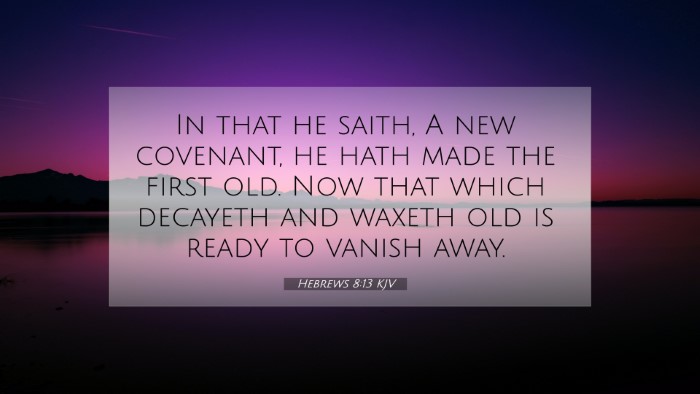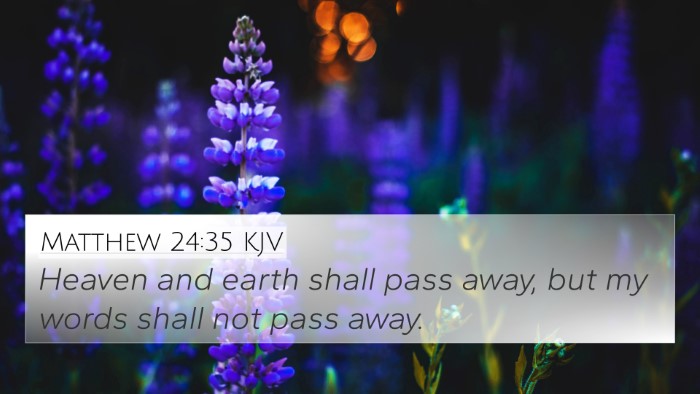Old Testament
Genesis Exodus Leviticus Numbers Deuteronomy Joshua Judges Ruth 1 Samuel 2 Samuel 1 Kings 2 Kings 1 Chronicles 2 Chronicles Ezra Nehemiah Esther Job Psalms Proverbs Ecclesiastes Song of Solomon Isaiah Jeremiah Lamentations Ezekiel Daniel Hosea Joel Amos Obadiah Jonah Micah Nahum Habakkuk Zephaniah Haggai Zechariah MalachiHebrews 8:13 Similar Verses
Hebrews 8:13 Cross References
In that he saith, A new covenant, he hath made the first old. Now that which decayeth and waxeth old is ready to vanish away.
Uncover the Rich Themes and Topics of This Bible Verse
Listed below are the Bible themes associated with Hebrews 8:13. We invite you to explore each theme to gain deeper insights into the Scriptures.
Hebrews 8:13 Cross Reference Verses
This section features a detailed cross-reference designed to enrich your understanding of the Scriptures. Below, you will find carefully selected verses that echo the themes and teachings related to Hebrews 8:13 KJV. Click on any image to explore detailed analyses of related Bible verses and uncover deeper theological insights.
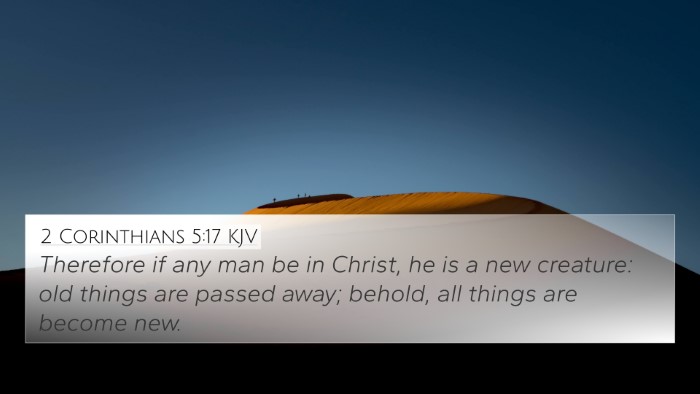
2 Corinthians 5:17 (KJV) »
Therefore if any man be in Christ, he is a new creature: old things are passed away; behold, all things are become new.
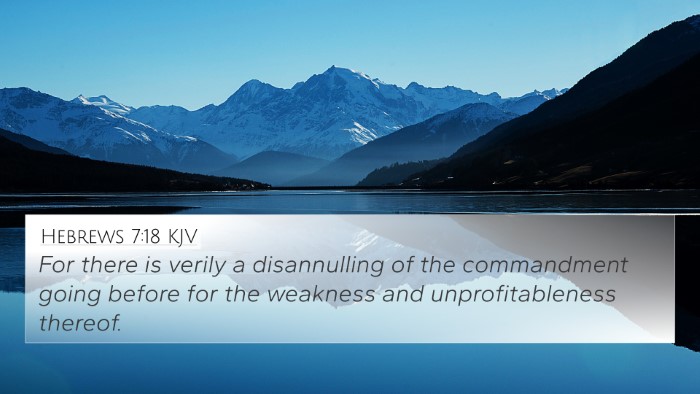
Hebrews 7:18 (KJV) »
For there is verily a disannulling of the commandment going before for the weakness and unprofitableness thereof.
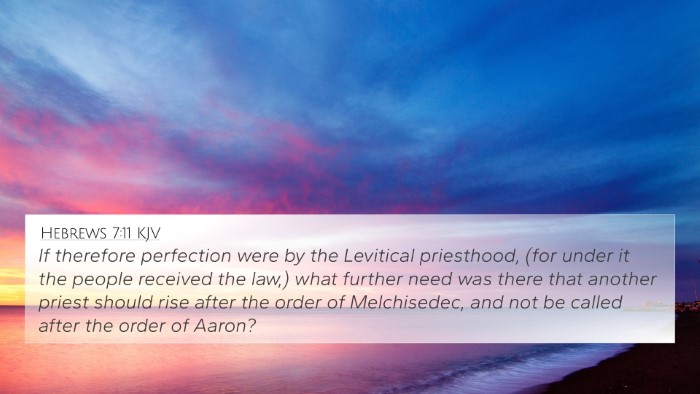
Hebrews 7:11 (KJV) »
If therefore perfection were by the Levitical priesthood, (for under it the people received the law,) what further need was there that another priest should rise after the order of Melchisedec, and not be called after the order of Aaron?
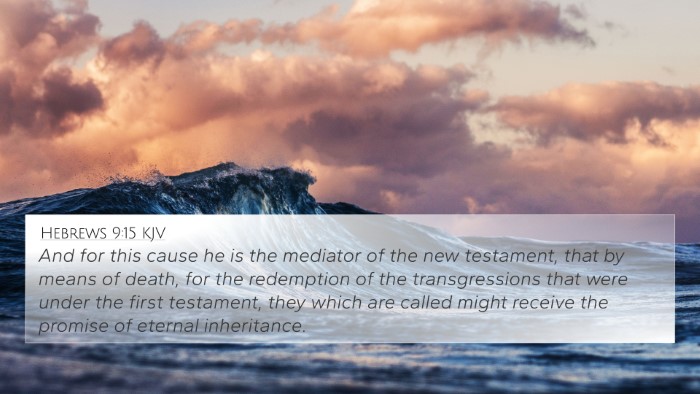
Hebrews 9:15 (KJV) »
And for this cause he is the mediator of the new testament, that by means of death, for the redemption of the transgressions that were under the first testament, they which are called might receive the promise of eternal inheritance.
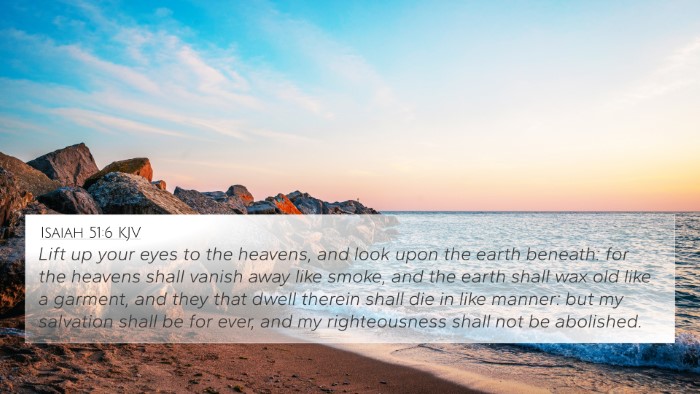
Isaiah 51:6 (KJV) »
Lift up your eyes to the heavens, and look upon the earth beneath: for the heavens shall vanish away like smoke, and the earth shall wax old like a garment, and they that dwell therein shall die in like manner: but my salvation shall be for ever, and my righteousness shall not be abolished.
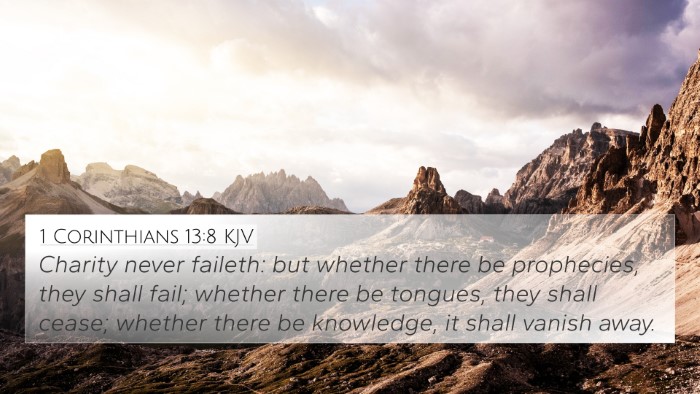
1 Corinthians 13:8 (KJV) »
Charity never faileth: but whether there be prophecies, they shall fail; whether there be tongues, they shall cease; whether there be knowledge, it shall vanish away.
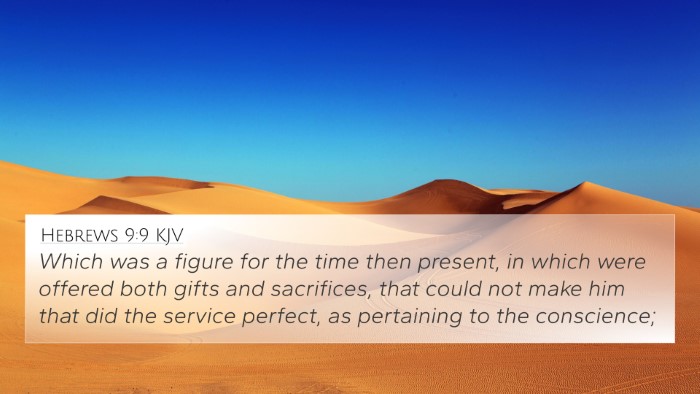
Hebrews 9:9 (KJV) »
Which was a figure for the time then present, in which were offered both gifts and sacrifices, that could not make him that did the service perfect, as pertaining to the conscience;
Hebrews 8:13 Verse Analysis and Similar Verses
Hebrews 8:13 - Understanding the Apostle's Message
Bible Verse: Hebrews 8:13 - "In that he saith, A new covenant, he hath made the first old. Now that which decayeth and waxeth old is ready to vanish away."
This verse plays a pivotal role in understanding the transition from the old covenant to the new covenant established by Christ. Here, the Apostle outlines the obsolescence of the former covenant in light of the new one that brings grace and redemption.
Meaning and Analysis
The verse asserts that with the proclamation of a new covenant, the old covenant is rendered obsolete. This signifies a significant theological shift for both Jewish and Gentile believers. The commentaries provide insights into this transition:
- Matthew Henry: Emphasizes the superiority of the new covenant, which replaces the flawed old covenant. He highlights that the old was never intended to be permanent and that its purpose was to lead to Christ.
- Albert Barnes: Discusses the concept of "decay" associated with the old covenant, which signifies its end. He remarks on the inevitability of change and renewal within God's plan, symbolizing hope and restoration for believers.
- Adam Clarke: Focuses on the historical context of the ancient covenant and its limitations, asserting that the new covenant is characterized by internal transformation rather than external adherence to the law.
Thematic Connections in Scripture
This passage connects deeply with various themes throughout the Bible. Understanding Hebrews 8:13 involves considering its relation to other scriptures:
- Jeremiah 31:31-34: This passage prophesies the new covenant, providing foundational understanding of the covenant shift described in Hebrews.
- Luke 22:20: Here, Jesus establishes the new covenant in His blood during the Last Supper, directly linking His sacrifice to the fulfillment of the promises made in the Old Testament.
- 2 Corinthians 3:6: Paul contrasts the "letter" of the law with the "spirit" of grace, echoing the message of Hebrews regarding the limitations of the old covenant.
- Romans 7:6: Describes believers being released from the law, thereby reflecting on the themes of liberation inherent in the new covenant.
- Galatians 4:24-26: Illustrates the distinction between the old and new covenants, emphasizing the freedom found in Christ.
- Hebrews 10:9-10: Expands upon the idea of the old covenant being set aside for the offering of a new way through Christ’s sacrifice.
- Colossians 2:14: States that Christ blotted out the handwriting of ordinances against us, further illuminating the message of the obsolescence of the old covenant.
Cross-Referencing Biblical Texts
In studying Hebrews 8:13, using tools for cross-referencing can deepen comprehension. Here are some ways to engage in cross-referencing:
- Utilize a Bible concordance to find keywords related to covenants.
- Refer to a cross-reference Bible study guide for thematic connections across different books.
- Employ a Bible reference resource to trace concepts of old versus new covenant.
Inter-Biblical Dialogue
The verse invites readers to contemplate how God's plan unfolds across the Scriptures. It engages in an inter-Biblical dialogue by inviting connections between the Old and New Testaments. Notable discussions include:
- The transformation of divine law from stone tablets to hearts, as seen in Ezekiel 36:26.
- The fulfillment of the law through Christ, highlighting both continuity and discontinuity in salvation history.
- The relevance of faith and grace over works, a theme echoed throughout Pauline epistles.
Conclusion
Hebrews 8:13 serves as a significant theological statement regarding the nature of covenants between God and humanity. This understanding can be enriched by continually exploring cross-references within Scripture, leading to a comprehensive analysis of God's unfolding redemptive story. As the Apostle points out, recognizing the transition from the old to the new covenant is not just an academic exercise, but a vital aspect of understanding the Christian faith and its implications for our lives today.
In summary, studying Hebrews 8:13 encourages believers to embrace the new covenant's transformative power while appreciating the historical context that leads to this divine promise.


